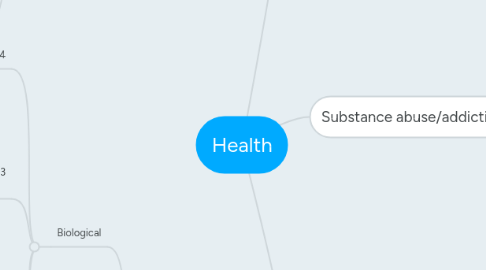
1. Aspects of stress
1.1. Biological
1.1.1. Cannon 1914
1.1.1.1. Flight and fight response finder person
1.1.2. Selye's General Adaptation Syndrome (3 stages)
1.1.2.1. 1. Alarm-Body increases sympathetic nervous system activity & activates adrenal glands to prepare us for "fight or flight", which by increasing our heart ♥ rate and breathing rates, as well as glucose availability (energy), increase our strength for fighting, etc.
1.1.2.2. 2. Resistance- Temperature, ♥ heart rate, b.p., respiration remain high while levels of hormones (e.g. adrenalin) continues to rise
1.1.2.3. 3. Exhaustion- If crises not resolved, resources become depleted, immunity drops, sometimes causing illnesses, ulcers, depression, or death
1.1.3. Kiecolt-Glaser et al. 1984: Cognitive / psychological factors Behaviors and beliefs Cognition - self-efficacy beliefs Sense of control Health knowledge Optimism - pessimism Stress an coping
1.1.4. Biological Genetics predisposition Immune system Viruses, infections, lesions Physiology Drugs Age Sex Nutrition
1.2. Cognitive
1.2.1. Reed et al 1999: HIV positive people with more pessimistic expectations : develop HIV related symptoms more quickly They die of AIDS sooner Expectations also seem to predict some of the immune changes associated with the disease
1.3. Social
1.3.1. Taylor 2002: Aim: whether there's a difference with gender and social support Method: meta-analysis research of stress and coping Results: there is a gender difference in relation to social support Women had more social support to others Drawing on socially supportive networks more consistently in times of stress More benefited by social support Conclusion: theory of "tend and befriend" Due to evolution, males and females have different stress responses - adaptive for sex Male: exhibit flight/fight response - triggered by testosterone Female - exhibit tender-befriend response - triggered by oxytocin Tend: nurturing activities Befriend: seeking social suppo
1.3.2. Sociocultural Context Family Social support Cultural influences Social norms (e.g. smoking / not smoking) Socio-economic status (SES) Pressure to change (peers, parents) Ethnicity Employment Health institution
1.3.2.1. Critical thinking: all factor influence stress no just one
2. Overeating/development of obesity
2.1. Biological
2.1.1. genetic predisposition
2.1.1.1. Stunkard et al 1990 Aim: investigate the relative role of genes and the environment Method: study 93 pairs of identical twins who were reared apart Compare their BMI Results: genetic factors accounted for 66-70 % of variance in body weight Conclusion: strong genetic component in development of obesity Genetics plays a role in those that were slim Evaluation: results do not indicate genetic factor in obesity However role of this factor is not clear Maybe because of metabolism - which can be genetically determined - more evidence required Maybe because of fat cells - which can be genetically determined - more evidence required Evidence that genes determine individual susceptibility to weight gain Obesity cannot be based on genetics alone - since increase in prevalence of obesity has taken over too short a period for genetic make-up of population to change substantially
2.2. Cognitive
2.2.1. Prevention Strategies
2.2.1.1. Stahre et al Aim: investigate the effectiveness of Cognitive behavioural therapy (helps patients understand the thoughts and feelings that influence behaviors.) Method: randomized trial with a group of obese women in Sweden. Half participated in program with elements of CBT Control participated in program that included moderate-intensity physical activity Treatment lasted for 10 hours, 2 hours a week Controlling particiants weight over 18 months Results: small number of drop outs Cognitive program: 8.6kg average loss at the end of the treatment Control: 0.7kg average loss at the end of treatment Conclusion: CBT is efficient Cost effective too
2.3. Social
2.3.1. Availability of food
2.3.1.1. Prentice and Jebb: change in what people eat Daily calorie intake grew by 25% in US from 1973 and 1999 Same trend in Netherlands, New Zealand and Spain Japan - calorie intake is low and stable; corresponds to the lowest rate of obesity Australia - daily calorie intake is moderate, but percentage of obesity increased by 23.4% Increase in calorie alone cannot explain increase in obesity
2.4. Critical thinking: all factor influence stress no just one
3. Substance abuse/addictive behaviour
3.1. Biological
3.1.1. Effects of nicotine- Stimulate adrenaline release - increase heart rate and blood pressure
3.1.2. DiFranza et al: Aim: find out whether people get addicted to cigarettes Method: longitudinal study of 217 adolescents (mean age of 12) in US Mostly European American that have inhaled a cigarette at least once They performed psychological evaluations and reported history of tobacco use Answered questions about attitudes and beliefs, social environment, family and community 11 interviewed Assessing tobacco dependence based on reported cravings, time devoted to smoking and inability to quit Results: adolescents who had an immediate experience of relaxation after first puff were more likely to become addicted 67% claimed relaxation effect after first inhale 29& didn't experience such effect Conclusion: post-inhale relaxation was a big research for addiction Of those who experience relaxation ,91% were unable to quit 60% lost control Takes far less to become addicted than what they previously thought Still unknown why some people are more sensitive to nicotine than others
3.1.3. Zyban: drug in 1990's to help people give up smoking Originally antidepressant Acts on the sites in the brain affected by nicotine Helps people quit - relieves withdrawal symptoms Blocks effects of nicotine if people resume smoking
3.2. Social/ Cognitive
3.2.1. Advertising agencies know that manipulating cognition is a powerful tool Self-image and beliefs are important If you belief that smoking is cool - you'd smoke more
3.2.2. Unger et al 2001 Aim: whether adolescents smoke more if their peers do Method: cross-cultural survey on US adolescents (mean age 13) smoking Results: European American students who had peers who smoked were more likely to smoke than others Conclusion: individualistic cultures - adolescents create own youth, characterized with rebellion to set themselves apart from their parents Collectivistic cultures - bond between teen and parent is important, and rebellion is not tolerated, therefore adolescents are more likely to conform to roles and norms that their parents set
